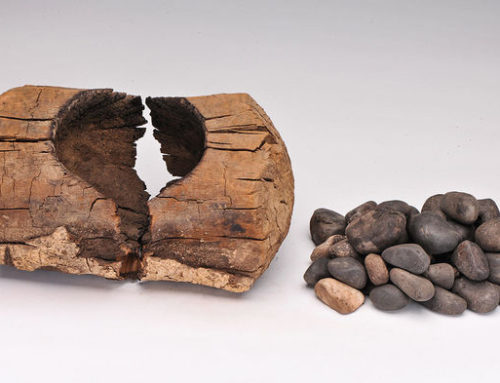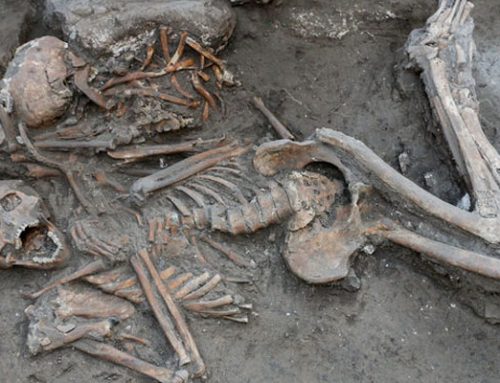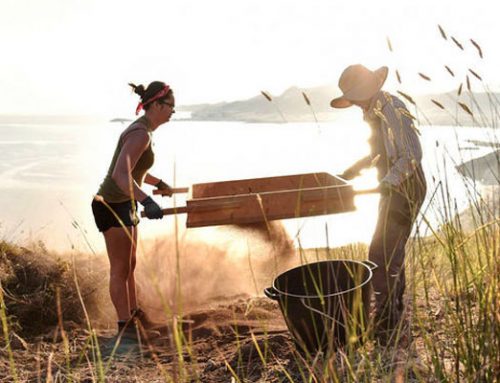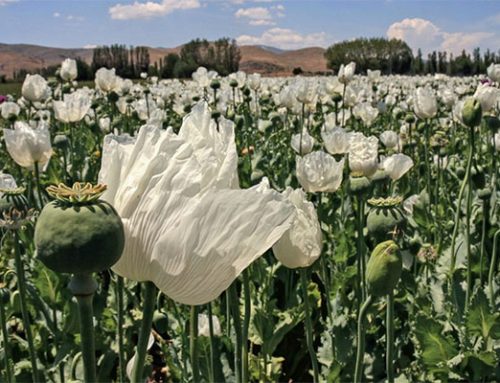Researchers work to transform China’s development boom from a curse into a blessing for ancient sites
CHENGDU, CHINA—Amid tangles of highways and phalanxes of high rises in this booming capital of Sichuan province, more than 30 hectares of prime urban real estate—three times as large as New York City’s Battery Park—is meticulously landscaped around two massive glass, steel, and stone pavilions. But unlike many of the high-rise buildings, this $75 million, 2-year-old complex is not the modern headquarters of a successful Chinese corporation. Instead, it is a museum paying homage to a 3000-year-old settlement and its surprisingly rich culture, which until recently was completely unknown.
 This sprawling ancient site, called Jinsha, lies 1000 kilometers from the traditional center of Chinese civilization along the Yellow River (see p. 934) and deep within a region long assumed to have been a cultural backwater until it was absorbed into the Qin dynasty in the 3rd century B.C.E. In recent decades, however, archaeologists have uncovered astonishing evidence of sophisticated and largely independent cultures in the region dating back to 2500 B.C.E., cultures that are helping to rewrite the origins of Chinese civilization (see p. 930).
This sprawling ancient site, called Jinsha, lies 1000 kilometers from the traditional center of Chinese civilization along the Yellow River (see p. 934) and deep within a region long assumed to have been a cultural backwater until it was absorbed into the Qin dynasty in the 3rd century B.C.E. In recent decades, however, archaeologists have uncovered astonishing evidence of sophisticated and largely independent cultures in the region dating back to 2500 B.C.E., cultures that are helping to rewrite the origins of Chinese civilization (see p. 930).
A decade ago, Jinsha was still buried. Until its accidental discovery during a construction project, the site was verdant farmland on the outskirts of a city with a mere 5 million people. Today, thanks to savvy archaeologists and their allies in city government, the new Jinsha Site Museum not only offers a welcome haven from urban sprawl but also sets aside a large area for future digs. The excavated area is covered with a vast glass roof, and a separate building houses state-of-the-art exhibits. Chengdu hotels and department stores proudly sport the site’s icon, a gold sun disk surrounded by four birds, as a symbol of the city’s unique past.
Jinsha creates a place of beauty, bolsters civic pride, and pulls in tourists—and its success is encouraging other cities to follow suit. “Dozens of local governments have come to see this,” says Zhu Zhangyi, 49, who is now the museum’s vice curator. “It has become a model.” Western archaeologists are deeply impressed, too. “The priority is to teach people about their past,” says Gary Crawford of the University of Toronto, Mississauga, in Canada. “They are willing to put real money into that—and we could learn some lessons from that.”
Archaeologists say models such as this are desperately needed in a country developing more rapidly than any other in human history. Half of the world’s concrete is poured in China. There are more than 2 million kilometers of highways, double the amount there was in 1986. And cities like Chengdu— which now boasts more than 10 million people and adds a million a year—have mushroomed, eating up land along rivers and on plains typically favored by ancient peoples. The pace of construction threatens to destroy sites ranging from Paleolithic campsites to Han royal tombs, and with them, a treasure trove of data critical for understanding the role of East Asia in early human migrations, animal and plant domestication, and urbanization.
Halting or even slowing development in a society eager to emerge from rural poverty is not possible. Instead, archaeologists are exploring creative ways to collaborate with both government and developers, and using museums like Jinsha’s to build popular support forpreserving key sites. Thus China’s development boom is powering a new wave of archaeological discovery and appreciation even as it threatens sites. Courts are increasingly willing to enforce harsh penalties on looters (see sidebar, this page). And in a dramatic departure from the past, local governments are now willing to lend support and funds to preserve sites. “It was a great fortune we discovered [Jinsha] in 2001,” says archaeologist Zhu, who led the team that examined the site just ahead of developers. “If it had been earlier, it would have been impossible to preserve the whole area.”
During a recent visit by Science, however, archaeologists at several provincial centers also warned that they must race to keep up with the bulldozers and have largely set aside purely academic endeavors in order to rescue sites. The recent economic downturn, rather than easing the pace, has only quickened it, as the central government pumps hundreds of billions of dollars into dams, canals, and highways to stimulate the economy. Says Zhu: “We have to do our best to persuade our government that if it doesn’t move aggressively to protect sites, there will be nothing left in 10 or 20 years.”
Water over the dam?
The current boom is hardly the first threat to China’s past. Qin Shi Huang, the man credited with first unifying China in the 3rd century B.C.E., consolidated the Great Wall and left behind the famous terracottaarmy in his mausoleum—two of the modern nation’s most famous tourist attractions. But he also ordered that evidence of previous rulers be destroyed in order to ensure his importance in history. More than 2 millennia later, China’s revolutionary leader Mao Zedong encouraged his people to obliterate “old ways of thinking,” triggering the destruction of thousands of ancient buildings and artifacts. During the years of the Cultural Revolution in the late 1960s and early 1970s, archaeological publishing ceased, university courses were restricted to political subjects, and many researchers were forced out of their jobs.
Today, the more insidious threat is not to China’s visible past but to the undiscovered sites that lay safely underground until recent development. The most infamous example of this third wave of destruction is the Three Gorges Dam project, which began in 1993 and eventually drowned a 600-kilometer stretch of the middle Yangtze River. The government initially allotted $37.5 million for archaeological salvage, although archaeologists called for at least $500 million. The amount was only marginally increased, and salvage work was not finished before the dam was completed in 2006 (Science, 1 August 2008, p. 628). “We may have missed a few sites,” says one Chinese archaeologist sheepishly.
Other massive projects have received less publicity but are having a tremendous impact. The $8 billion South-North Water Transfer Project will divert water from the wetter areas of central and southern China to its thirsty north, through a complex mix of reservoirs, canals, and dams. When complete by 2014 (Science, 25 August 2006, p. 1034), the central route—an average of 110 meters wide—will cut across nearly 1300 kilometers, much of it in central Henan Province, which is traditionally considered the homeland of Chinese civilization.
Ma Xiaolin, vice-director of the Henan Provincial Institute of Cultural Relics and Archaeology in Zhengzhou, says work on the canal has uncovered some 340 sites in Henan alone, from Neolithic settlements to Tang Dynasty tombs. Ma says time and funding for salvage work are ample, but there are complications. Archaeologists are now excavating a 2000-year-old king’s tomb and have requested that the government alter the canal route. “No decision has been made,” says another scientist familiar with the site. “It’s a sensitive issue.”
That sensitivity reflects the tension between development and preservation. China passed a heritage protection law in 1982, but archaeologists say it was only haphazardly enforced until recently. “In past decades, we were in a very bad position,” says Wang Yi, who leads the Chengdu City Institute of Archaeology and Cultural Relics. “Since the first law was passed 27 years ago, we have been fighting against developers. And in the past, local governors were enemies of archaeologists. … We could not counter a city’s development.”
But that is changing. In 1997, the government made violations of cultural heritage laws a criminal act punishable by jail terms and even the death penalty. In Chengdu, the manager of a real-estate company went to jail for 5 years for failing to do archaeological salvage work before construction. “There have been those who destroyed sites and artifacts—but now, if they do, they get in big trouble,” says Wang. “Even government officers don’t dare break this law.”
Hearts and minds
Along with the legal stick comes a carrot. Both the city and provincial government see that development “is not just about an increase in GDP,” asserts Wang. “We have to make this mainstream, so that all branches of government and citizens support archaeology.” He and a growing number of other Chinese researchers are increasingly involved in outreach activities to create a broader constituency for protecting sites. “It is impossible not to lose some sites,” says Wang Wei, director of the Institute of Archaeology in Beijing. “But the public is starting to appreciate the importance of cultural heritage—and that you can move the site of a planned building.”

The archaeologists’ efforts can be seen in a new and surprising phenomenon: multimillion dollar popular archaeological museums that have opened in recent years across China, sporting three-dimensional movies, elegant restaurants, and exhibits that equal or surpass those in major U.S., European, and Japanese cities. Many, like the Jinsha museum, are on land protected from further development. “For less than $100 million, the Chengdu municipal government bought a history 1000 years older than it had before,” Zhu says over sushi in the chic museum restaurant.
In another example, last October a gleaming monument of Iranian marble opened outside the southern port city of Hangzhou to celebrate Liangzhu, which started flourishing around 3500 B.C.E. and is one of the oldest major settlements in China. Now 42 hectares around the site have been protected from major development. When a real-estate company sought to buy neighboring land, the government sold it for under market value in exchange for nearly $24 million for the museum and private-sector expertise in big projects. “This was a real innovation,” says archaeologist Jiang Weidong, director of the Liangzhu Museum, over tea in his sleek Bauhaus-style office.
The exhibit lays out methods of excavation, the evolution of the site, and the day-to-day life of its people 5000 years ago, using cutting-edge artifacts, films, and displays. Visitors can even walk through a recreation of the settlement, showing both the jade-wearing elite—who were buried in elaborate tombs high on earthen platforms— as well as modest tradespeople and rice and millet farmers in wattle-and-daub houses.
Back in Chengdu, archaeologists are also using their facilities to win the hearts and minds of their citizens. After the 2008 Sichuan earthquake, curators at Jinsha opened the grounds to more than 40,000 people who camped out amid fears of aftershocks. To mark the first anniversary of the disaster in May, they waived admission fees and drew an impressive 50,000 citizens. Regular festivals promote the site as a cultural oasis amid the city’s congestion.
Such efforts raise awareness of the nation’s heritage, and plans for park and museum complexes at ancient sites are taking hold all over China, from the 3500-year-old city of Erlitou in the central plains to the ancient Silk Road city of Turfan in the far western province of Xinjiang (see p. 940). In May, a new underwater museum opened along the Yangtze, preserving 1200-year-old poetic inscriptions and measurements of annual high-water levels on rock from the waters impounded by the Three Gorges Dam. Such museums also provide opportunities for archaeologists themselves, and some scholars who studied abroad are now finding ways to return to China for research or even permanently (see sidebar, p. 938).
Getting the goods
In the rush to modernize, modest prehistoric settlements are at particular risk, although sometimes they can win a reprieve. In Shaanxi province, west of the central plains, for example, construction of a vehicle factory was put on hold after the discovery of an unusually complex, moated, Neolithic site with a line of pottery kilns suggesting specialized handcrafts, dated to a surprisingly early 4000 B.C.E. “The site was preserved, and the provincial government paid dozens of millions of yuan [tens of millions of U.S. dollars] to move the factory,” says Wang Weilin, vice director of the Shaanxi Archaeological Institute.
Wang, whose organization includes 130 archaeologists, says developers pay nearly $3 million annually to cover the costs of salvage work in his province. But he is particularly concerned about smaller sites without dramatic architecture and artifacts. “We see traces of such sites, but we worry we might not catch up with development,” he says. Harvard University archaeologist Rowan Flad, who is collaborating with Wang, notes that international efforts “are often the only way Back in Chengdu, archaeologists are also using their facilities to win the hearts and minds of their citizens. After the 2008 Sichuan earthquake, curators at Jinsha opened the grounds to more than 40,000 that work beyond that of a salvage nature can get done,” because of the time pressures on Chinese institutes.
Smaller, more ancient sites are also at greater risk because they typically lack what Chinese archaeologists privately call “hao dongxi,” which can be roughly translated as “goodies” in English. “There is a tendency among some Chinese archaeologists to look for the goodies, that is, the grave goods with artistic merit and which embody China’s cultural heritage,” says Magnus Fiskesjö, an anthropologist at Cornell University. “Fishbones don’t qualify.”
As a result, material with the potential for providing critical data on scientific questions, such as ancient diet, health, and social organization—including fishbones—is often overlooked, particularly during fast-paced salvage digs. Even human bones are often still disposed of rather than analyzed, says Fiskesjö.
That tendency is changing, albeit unevenly. In Zhengzhou, Ma, who studied at La Trobe University in Melbourne, Australia, is eager to show off his labs and storage facilities, which include well-labeled blue bins of human and animal bones from a host of sites. “Smaller institutes just collect artifacts and throw away the rest,” he says. “We want to focus on new techniques involving plants, animals, and human skeletons and set up databases for each site.” With a healthy $3 million annual budget, Ma’s institute has the funds to do more detailed research. But the organization is now juggling a dozen excavations, and he expects to conduct more than 30 digs this year alone—90% of which are salvage operations.
Despite—and because of—the pace of development, archaeologists in China appear surprisingly optimistic. “Given the investment from our government, the 21st century will be a golden age for archaeology in Sichuan,” predicts Chengdu’s Wang. With an interested public plus provincial government coffers filled by the economic boom, China is now paying heed to its archaeological treasures in a way that once might have been criticized as a bourgeois luxury. Says Jiang, smiling over green tea in his sun-filled office: “When your granary is full, you pay more attention to ceremony.”
Science-2009-Lawler-Archaeologists_Raise_The_Old_With_the_New-936-40.pdf




